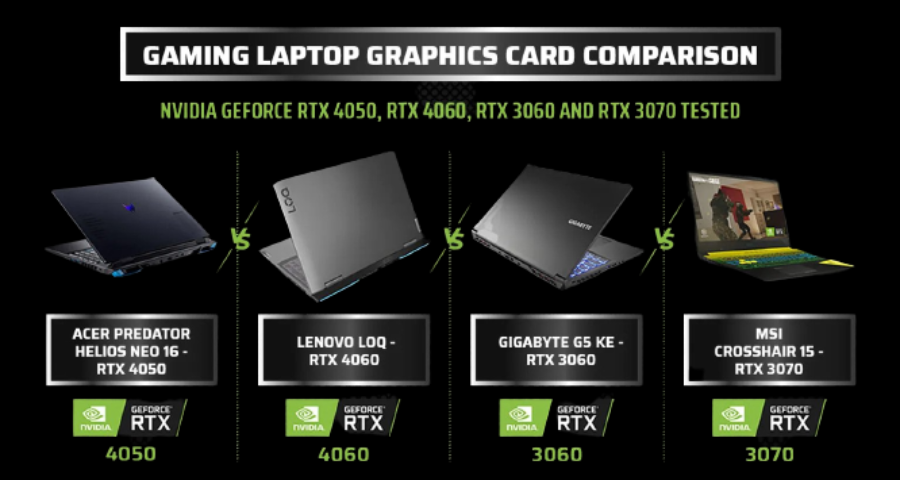Gaming laptops are a rapidly changing industry. The capabilities of a gaming laptop are always being pushed by newer hardware and technology. This is particularly evident in the market for inexpensive gaming laptops, which are increasingly equipped to handle the spectacular games that are being published nowadays. The dedicated GPU or graphics card is the most crucial piece of hardware when discussing gaming laptops. This is what powers how well you play video games. When it comes to laptop GPUs, there are two big companies on the market: NVIDIA, which is the most well-liked, and AMD, which is closely behind. In this guide we will discuss about gaming laptop graphics card comparison.
Breakdown of NVIDIA GPU Comparisons
The NVIDIA GeForce RTX 4050 and RTX 4060 are the company’s most recent low-cost gaming GPU models, which we’ll be comparing in this post. This year, we evaluated quite a few laptops with the new GPUs. The NVIDIA GeForce RTX 3060 and RTX 3070 from the previous generation will be used as a comparison. All laptops with these laptop GPUs are currently available for sale in the same price range. Therefore, RTX 3060 laptop prices are comparable to RTX 4050 laptop prices. The RTX 3070 and RTX 4060 behave similarly. This article’s goal is to assist you in selecting a laptop GPU that will provide greater performance and portability.
Review of the Acer Predator Helios Neo 16
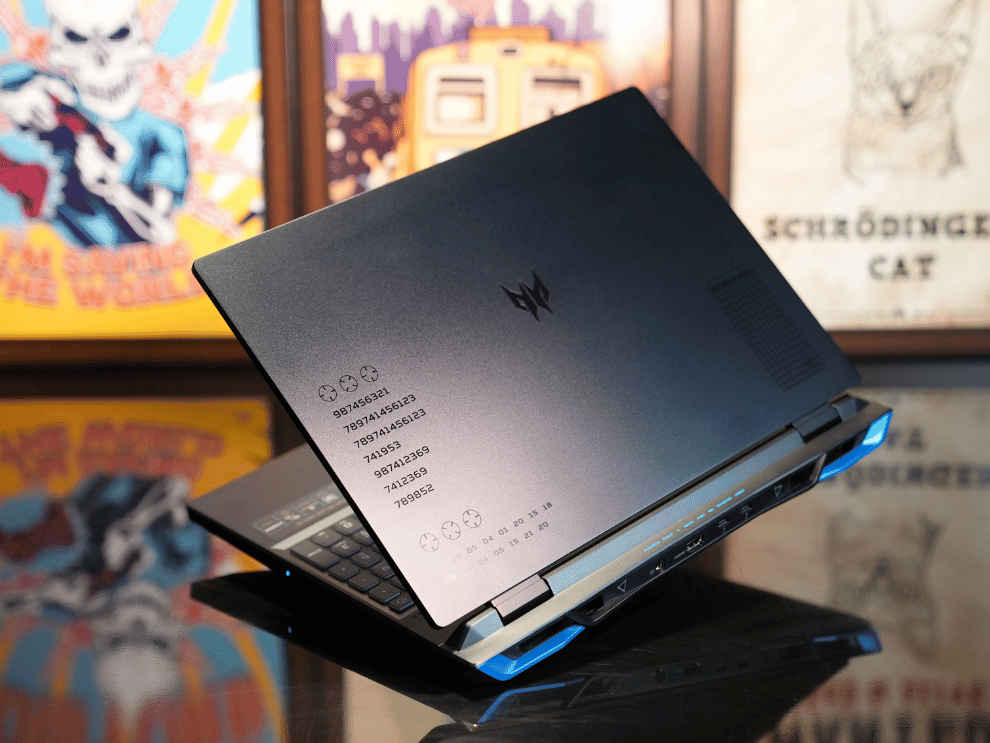
The Acer Predator Helios Neo 16 with an NVIDIA GeForce RTX 4050 Laptop GPU is our top contender. Here is a brief summary of the technical data and our evaluations of performance.
Specs for the Acer Predator Helios Neo 16
GPU: NVIDIA GeForce RTX 4050 Laptop GPU
TGP: 115W
CPU: Intel Core i7-13700HX
RAM: 16GB DDR5-4800
Price: Rs 1,19,990
Acer Predator Helios Neo 16 Digit Ratings
Performance: 83
Display: 80
Synthetic Benchmark: 78
Real World Gaming: 86
Review of Lenovo LOQ

The freshly announced Lenovo LOQ, which has an NVIDIA GeForce RTX 4060 Laptop GPU, is our second contender. Here is a brief summary of the technical data and our evaluations of performance.
The Specifications of the Lenovo LOQ
GPU: NVIDIA GeForce RTX 4060 Laptop GPU
TGP: 115W
CPU: Intel Core i7-13620H
RAM: 16GB DDR5-5200
Price: Rs 1,14,990
For the Lenovo LOQ, the Digit Ratings
Performance: 90
Display: 83
Synthetic Benchmark: 87.5
Real World Gaming: 100
Review of the Gigabyte G5 KE

The Gigabyte G5 KE, the third laptop in our evaluation, has an NVIDIA GeForce RTX 3060 laptop GPU. Here is a brief summary of the technical data and our evaluations of performance.
Gigabyte G5 KE Specifications
GPU: NVIDIA GeForce RTX 3060 Laptop GPU
TGP: 115W
CPU: Intel Core i5-12500H
RAM: 16GB DDR4-3200
Price: Rs 79,990
Ratings for the Gigabyte G5 KE in digits
Performance: 74
Display: 63
Synthetic Benchmark: 80
Real World Gaming: 78
Also Read: THE ULTIMATE GUIDE: BEST LAPTOPS UNDER 40000 WITH I7 PROCESSOR AND 8GB RAM
Review of MSI Crosshair 15

The MSI Crosshair 15 with an NVIDIA GeForce RTX 3070 Laptop GPU is our last contender. Here is a brief summary of the technical data and our evaluations of performance.
Specifications for the MSI Crosshair 15
GPU: NVIDIA GeForce RTX 3070 Laptop GPU
TGP: 140W
CPU: Intel Core i7-12700H
RAM: 16GB DDR4-3200
Price: Rs 1,40,990
Ratings in Digits for the MSI Crosshair 15
Performance: 82
Display: 70
Synthetic Benchmark: 96
Real World Gaming: 81
Since the xx70 series cards are considered “high-end” GPUs, the RTX 3070 has the highest TGP of all the cards. Therefore, it does have an advantage over every other card in this deck in terms of raw power.Before we begin this comparison, it’s important to keep in mind that each of these laptops has a distinct processor. You will notice some variances in FPS figures when it comes to games that require a lot of processing power, even though their performance is not significantly different. The GPUs will still have the biggest impact on the performance metrics here, but it shouldn’t be by much. Having said that, let’s get going!
Performance of a Synthetic GP
The synthetic GPU benchmark is where we begin. Performance of DirectX 11, DirectX 12, and Ray Tracing is evaluated using the 3DMark benchmark.
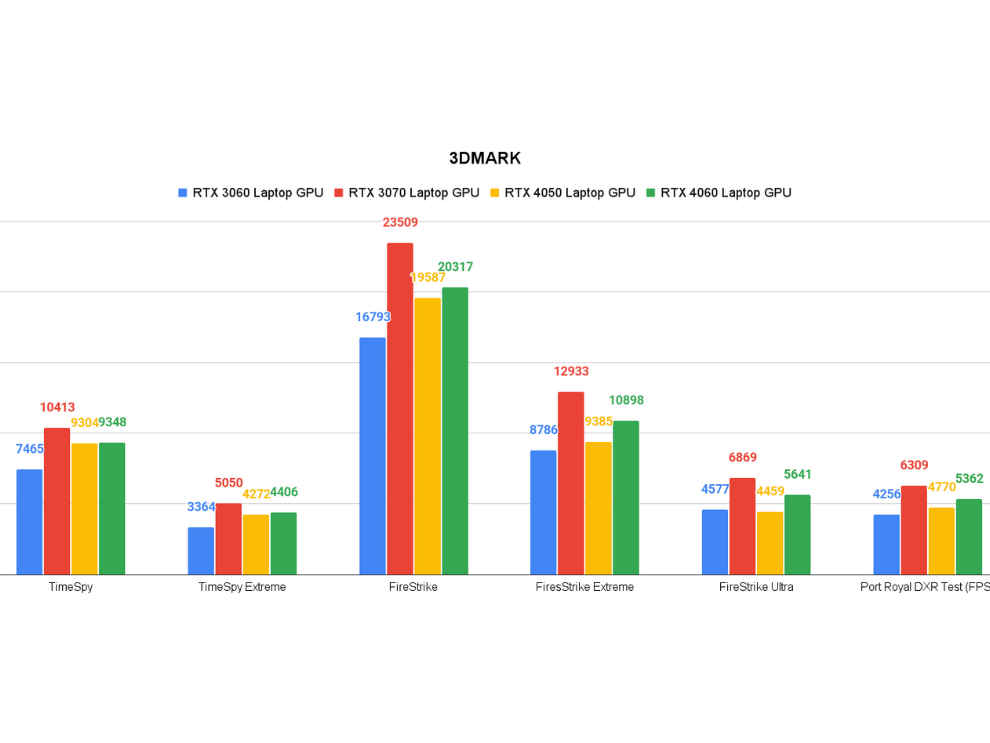
The RTX 3070 outperforms every GPU in this comparison, as seen by the graph. It makes sense when you take into account its TGP of 140W, and there is some justification for calling it a higher-end GPU. The rest is roughly what you would anticipate. As you can see, the newer RTX 4050 performs better with DirectX 12 than the more aged RTX 3060. In terms of DirectX11 performance, the RTX 3060 outperforms the RTX 4050. This is significant because while newer games will support DirectX 12, older games that don’t will perform better on the RTX 3060. The RTX 4060 performs similarly to the RTX 4050 in DX12 but substantially better in DX11 with just the RTX 3070 outperforming it.
Performance in Real-World Gaming
That brings us to how well games work in actual settings. Synthetic benchmarks are a respectable approach to assess a laptop’s gaming performance, but in the end, real-world gaming performance is what counts. We conduct all of our real-world gaming testing in FHD (1920x1080p) resolutions with the high and medium default settings for each game.The RTX 3070 should win this contest based on our artificial GPU findings, but actual gaming performance data tells a different tale.
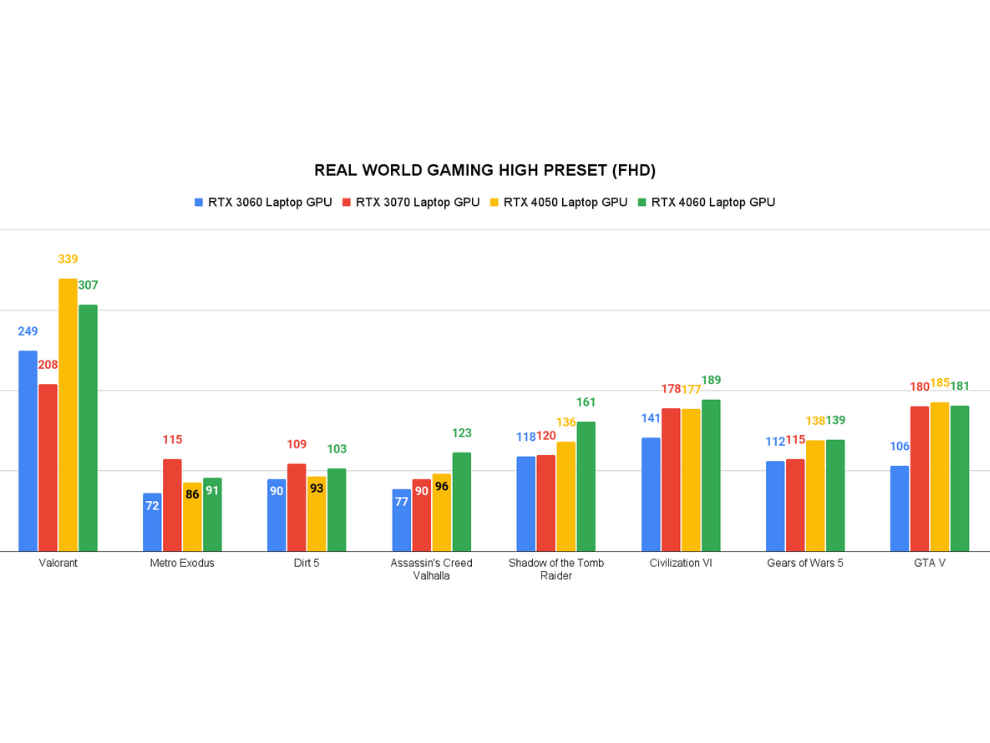
The high preset of real-world gaming benchmarks is where we begin. The RTX 3070 only achieves the top FPS ratings in two games, while being the GPU with the highest synthetic benchmark results. Here, the RTX 4060 outperforms the competition, with the RTX 4050 providing some fierce opposition. In fact, in every single gaming benchmark, the RTX 4050 easily surpasses the RTX 3060. Be aware that each of these games supports DirectX12. It’s also important to note that, of the four laptops being evaluated, the one with the RTX 4050 graphics card has the strongest processor.
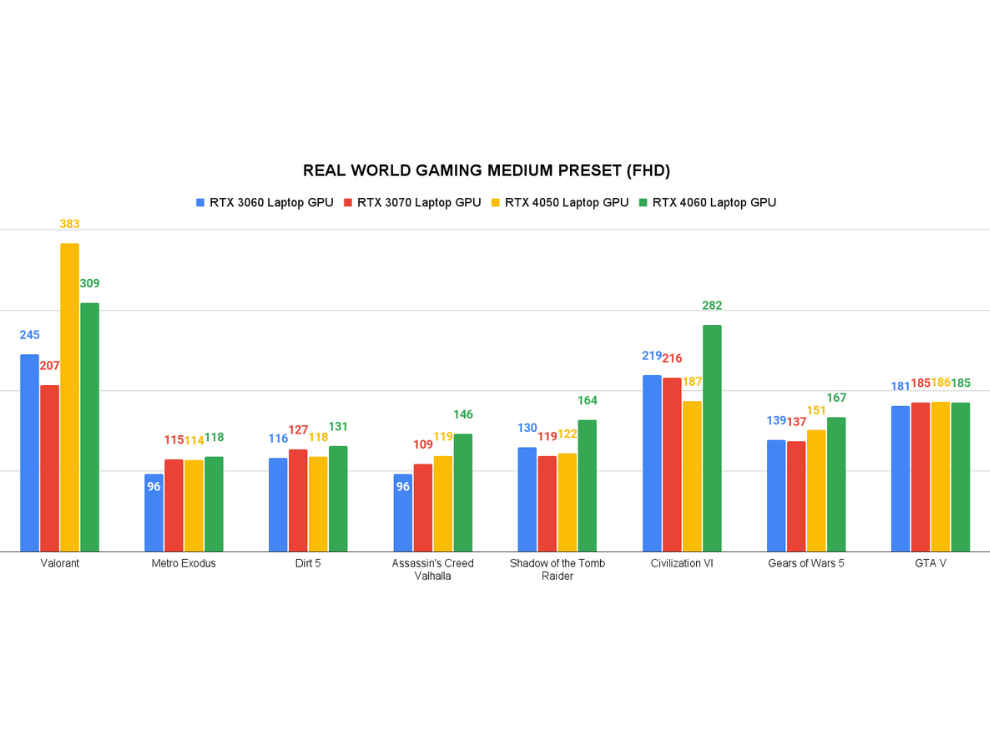
The gap is even more pronounced when it comes to real-world gaming benchmarks’ medium preset, where the RTX 4060 consistently achieves the highest scores across the board. The FPS statistics of the RTX 3060 and RTX 4050 are typically either very similar or higher in favour of the RTX 4050.
The RTX 3060 and RTX 4050, while capable of handling higher resolutions, do require some adjustment in graphical settings, often necessitating a reduction to medium or low settings, depending on the specific game being played. However, they excel at delivering comfortable gameplay experiences at Full High Definition (FHD) resolutions. Worth noting is that the RTX 3060 and RTX 4050 come equipped with a slightly lesser 6GB of VRAM, which can occasionally pose limitations when aiming for higher resolutions. Nevertheless, the newer RTX 40 series cards incorporate significant enhancements like DLSS 3.0 (and soon 3.5), as well as advanced frame generation technologies. These improvements play a pivotal role in elevating overall performance, provided the game being played supports these features.
DLSS 3.5 represents a significant leap in AI-driven rendering technology, revolutionizing the gaming experience on RTX GPUs by delivering unparalleled smoothness and speed. With the introduction of DLSS 3.5, the RTX 40 series GPUs have gained a remarkable capability known as “frame generation.” This innovative feature enables these GPUs to intelligently “fill in the gaps” in rendering by harnessing the power of artificial intelligence. By utilizing AI algorithms, these GPUs can generate missing frames on-the-fly, ensuring a consistently smooth and fluid frame rate during gameplay—a capability notably absent from the RTX 30 series cards.
Also Read: 10 BEST LAPTOPS FOR CODING AND PROGRAMMING UNDER 40000: UNLEASH YOUR CODING POTENTIAL ON A BUDGET
Conclusion
With that, we’ve reached our conclusion for this comparison. While the NVIDIA GeForce RTX 3070 shines in synthetic benchmark performance, the RTX 4060 takes the lead in real-world gaming scenarios. If your primary goal is to find the optimal GPU for an entry-level gaming laptop, then the RTX 4060 should be your top choice. However, if you come across a great deal on an RTX 3070 laptop, it’s worth considering, though always keep in mind the Total Graphics Power (TGP) as it can significantly impact a laptop’s gaming performance. This consideration applies to any gaming laptop you’re contemplating; even an RTX 4050 with a higher TGP can outperform an RTX 4060.
For those with budget constraints, opting for the RTX 4050 over the RTX 3060 is a wise decision, as it offers superior gaming performance, especially in newer titles. Additionally, the inclusion of DLSS and advanced frame generation technology gives it a notable advantage. In summary, we recommend choosing a more recent RTX 40 series gaming laptop to fully leverage NVIDIA’s cutting-edge technology and enjoy an enhanced gaming experience.
